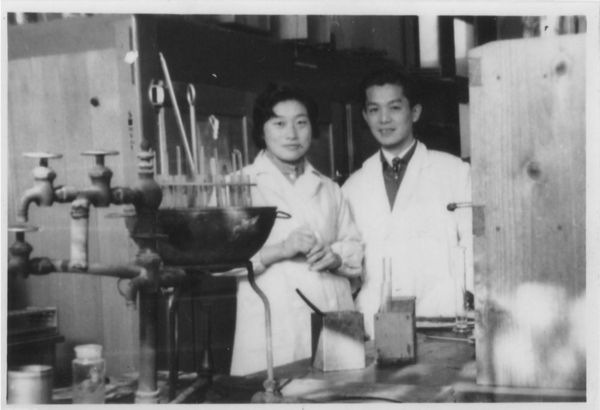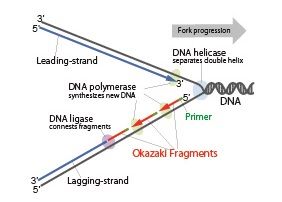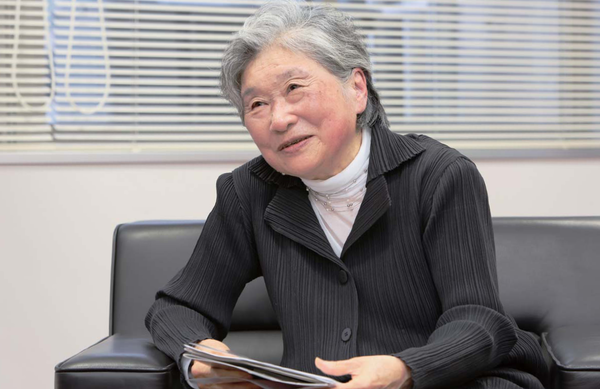Features
Features
My Life & Okazaki Fragments
- ツイート
- 2017/06/19
Special Interview
University Professor Tsuneko Okazaki
Source: IAR Letter, vol.15, March 2017
*about IAR: Nagoya University's Institute for Advanced Research was established to produce internationally recognized academic research of the highest caliber, and to contribute to society through the research achievements at the Institute.
Dr. Tsuneko Okazaki is a molecular biologist renowned for her discovery of the Okazaki fragments with her husband Dr. Reiji Okazaki. Even after the early death of Dr. Reiji Okazaki in 1975, she continued their research and clarified the mechanisms of discontinuous DNA replication.
She graduated from Nagoya University in 1956 and received a PhD in Science from the same university in 1963. She was awarded a Fulbright travel grant and studied in the USA from 1960 to 1963; she studied as a fellow in 1960-1961 at Washington University, School of Pharmacology (supervised by Dr. Jack L. Strominger) and from 1961-1963 at Stanford University, School of Medicine (supervised by Dr. Arthur Kornberg). She worked at the Graduate School of Science at Nagoya University as an assistant- (1965-1976), associate- (1976-1983) and full professor (1983-1997). She was also a full professor (1997-2002) and a visiting professor (2002-2008) of the Institute for Comprehensive Medical Science at Fujita Health University, and served as a director of the Japan Society for Promotion of Science, Stockholm Office (2004-2007) and president and CEO of Chromo Research Inc. (2008-2014). In 2016, she became a University Professor at Nagoya University and a member of the IAR Academy.
She has won numerous awards such as the L'Oréal-UNESCO Awards for Women in Science (2000), the Medal with Purple Ribbon (2000), the Order of the Sacred Treasure, Gold Rays with Neck Ribbon (2008) and the Person of Cultural Merit (2015).
-- Could you please explain what Okazaki fragments are?
OKAZAKI: DNA has a double helix structure. In replication of DNA, the double strands of the DNA helix are unwound to produce a new strand complementary to each strand. Conventionally, it was believed that there were two different enzymes, one elongating the strand from the 5' to 3' direction and another elongating the strand from the 3' to 5' direction. However, in fact, there was only one enzyme that elongates the strand from the 5' to 3' direction. So we attempted to explain how two strands were oriented in the double helix with only one enzyme. This is referred to as discontinuous replication.
We formulated a hypothesis that the reverse strand running in the opposite direction is synthesized in a series of short DNA fragments. What we did was to clarify the mechanism of how the synthesis of the strand proceeds involving various reactions such as binding the short DNA fragments together. Okazaki fragments are those short strands of DNA that are discontinuously synthesized in the reserve direction.
When we first started this research, we knew nothing at all about the strands, including their length. We took the strategy of labeling of the end of the fragments being elongated with short intervals and monitoring the shift of the labeled ends to see on which side they would be found. At first, the labels were found in the short fragments in a concentrated manner; however, the labels shifted to the longer fragments after being left for a while. We therefore assumed that the fragments were formed in a discontinuous manner although we had to take various steps before the assumption was proved.
We knew that DNA polymerase cannot start synthesis of DNA de novo but needs already existing, so-called primer termini, to start synthesis. We analyzed the primer termini used for the synthesis to see how the synthesis of these short fragments was started repeatedly. As the result, we found that these primers were short RNA primers. The RNA was broken down and the gaps thus produced were filled up with DNA and short DNA chains were bound together with an enzyme named ligase. It was proved that short fragments were accumulated with involvement of various reactions of the enzymes and the suppression of the enzymes. This finally clarified the discontinuous replication.
~My father showed me the process of bacterial cells
dying due to penicillin used for treatment.
I naturally became interested in organisms and bioscience.~
-- What motivated you to be interested in natural science?
OKAZAKI: I was born in Moriyama ward of Nagoya city. I grew up during the war. My father was a doctor; he lost his hospital in the war, and worked as a director of a hospital in Gamagori city. I was a junior high school student then and used to visit there, where I spent my summer holidays swimming in the sea or looking into a microscope. My father showed me the process of bacterial cells dying due to penicillin used for treatment. I naturally became interested in organisms and bioscience.
-- What was your reason for choosing biology in university?
OKAZAKI: My father planned to make all his children medical doctors. So by not choosing to enter the medical department I was an unworthy daughter.
Doctors need to be very sociable. They need to work with a lot of staff, and most of all, doctors should interact effectively with many patients. Because I was not a very sociable person, I thought I was not suited to being a doctor. So, instead of entering the medical department, I chose biology, since that was what I was most interested in.
-- In those days, there were only a few female researchers. How did you dare to become a female researcher?
OKAZAKI: At the time, female students in the department of biology where I was studying had difficulties finding a job. Other than being a researcher, teaching at a high school was the only choice of employment open to us. Today it is an era of bioscience and women are in gainful employment. But the situation was completely different then.
-- You met your husband, Dr. Reiji Okazaki, when you were a university student.
OKAZAKI: When I was in my senior year of university, I met Reiji who was working as a researcher then. We got married in the spring in which I advanced to the graduate school. We started our joint research in the same laboratory. Reiji was the type of scientist who thought of nothing else but his research, and as I recall we were totally absorbed in the research in those days.
Besides research, Reiji was very fond of sumo wrestling, and because we had no TV set, we used to go to an udon noodle shop where a TV set was installed to watch sumo broadcasts. There were no other entertainments actually.
 Reiji Okazaki and Tsuneko in the laboratory, 1958
Reiji Okazaki and Tsuneko in the laboratory, 1958
-- What was the research environment like?
OKAZAKI: Japan was still very poor in those days, and the research environment was incomparably poorer than it is today. The laboratory was a wooden building and there was a leak in the roof caused by the Ise Bay Typhoon, which damaged all our laboratory samples. We were short of research funds so we often bought reagents with money from our own pockets.
-- Then the two of you went to America...
OKAZAKI: In 1960, Reiji and I went to the U.S. by ship, on the Hikawa Maru, and studied in Washington University and Stanford University as recipients of the Fulbright travel expense scholarship. In Stanford University, we studied DNA polymerase in the laboratory of Professor Arthur Kornberg who won the Nobel Prize.
In 1963, Reiji was called back by Nagoya University and we returned to Japan. Reiji became an assistant professor while I returned to the doctoral course and obtained a Ph.D. After that, I became an assistant in Reiji's laboratory and started to work on the research with him.
 OKAZAKI FRAGMENTS
OKAZAKI FRAGMENTS
Okazaki fragments are short DNA fragments that are temporarily produced during DNA replication at the lagging-strand.DNA replication is started by separating the double helix by DNA helicase. Two complementary single-stranded DNA are formed, which will become templates for DNA synthesis. One of the single DNA strands is replicated continuously (leading-strand), but this is not possible for the other strand (lagging-strand). It is because DNA polymerase, the enzyme synthesizing new DNA, extends DNA strands in one direction only (from 5' to 3'). In the process of lagging-chain production, whose overall direction of elongation is from 3' to 5' Okazaki fragments are produced first in the direction opposite to that of fork progression and are later connected to form a complete long strand.
-- Were working conditions for women in the U.S. very different from those in Japan in those days?
OKAZAKI: A woman was not recognized as a full-fledged researcher in Japan back then. A woman researcher was not even given a post. That was the atmosphere of the time. Contrarily, in the States, I was recognized as full-fledged researcher. I appreciated that very much.
In Japan, it was the matter of course that women stayed at home raising their children. After I came back to Japan, I had my first child at the age of 30, and my second child at the age of 40. Unlike today, there was no framework for parenting support, such as nurseries to look after children. I had to make these arrangements on my own. I even took part in a citizen's campaign demanding improvement of nurseries.
-- How did you balance your research activities and child-raising?
OKAZAKI: It was very hard. I sent my children to a nursery but they came home at 3:00 or 4:00 in the afternoon. After that time, I hired a part-time baby-sitter to look after them. But even this arrangement was limited to 5:00 at the latest. Then, I had to go and pick them up, so I took them to the laboratory, put them in a big cardboard box and made them play there.
It was even harder after they went to elementary school, because they came home earlier. A person who used to work at my father's hospital lived in my neighborhood and she looked after my children after school. I owe her a great deal.
With respect to research, we started working on "discontinuous replication" from around 1964. We discovered the Okazaki fragments and published our results in 1967.
~People suggested that I should give up the research
because of the children.~
-- Your husband passed away in 1975.
OKAZAKI: He was in Hiroshima in the year World War II ended. About two years prior to his death, he showed bleeding on his skin and we knew that he suffered from leukemia. No treatment was available for leukemia back then. In 1975, he was called to an academic meeting in Canada, and died shortly after returning to Japan.
His death meant that the laboratory lost its boss and our children lost their father. People suggested that I should give up the research because of the children. At such time, my respected professor Kornberg in America sent me a letter, saying "never give up the research; the world is waiting for the outcome of your research at Nagoya." This letter encouraged me very much. My son was in the 6th grade of elementary school and my daughter was two and a half years old then. I asked the neighbor who had been baby-sitting my children to continue to look after them. I really owe her so much.
-- What sort of research did you do after your husband's death?
OKAZAKI: I continued the research that I had been doing with Reiji. I had competent joint researchers. The biggest mystery was the primer RNA -- how is it that short fragments are formed repeatedly? So we worked on isolating the primer and determining its structure.
--What is the significance of the research on Okazaki fragments and discontinuous replication?
OKAZAKI: We discovered the truth -- the concept of a primer, the role of the short sequence of bases to trigger DNA replication. Using this, methods such as PCR, to design a base sequence of a specific region as a primer and amplify gaps, are widely used now.
-- Who had the most influence on you?
OKAZAKI: There were many people who helped me and encouraged me. When Reiji passed away, I might have quit the research if it had not been for Professor Kornberg's letter encouraging me to continue with it. I also received encouragement from researchers all over the world.
~I think there must be very hard times,
but the most important thing is not to quit in any case.~
- Do you have any advice to younger women researchers or other working women about the balance between career and home?
OKAZAKI: I think there must be very hard times, but the most important thing is not to quit in any case. Difficult times or tough times are limited to a short while. Once you have gone through such times, children grow up. In the case of a researcher, if you quit, your post is likely to be filled by someone else, making it difficult for you to return to it. Today, supportive measures are taken by universities. Making use of these advantages, it is important to manage to get through hard times by taking holidays or decreasing working hours.
-- What do you think is important now, to give more opportunities for women?
OKAZAKI: I think it is desirable that a system should be available for women to return to work after leaving temporarily or to decrease their working hours for child-birth and child rearing. The support of nurseries is also important.
On top of that, another important factor is whether the family and surrounding people understand the situation and are willing to provide support. Criticism from parents or sisters or brothers is often very harsh. Many people together could change the public mind-set that says "keeping house and raising children is women's work."
My daughter lives in Sweden now. Men in Sweden know how to raise a child and do housework. They are good cooks too. The social environment is such that it is a common practice for men to do all kinds of housework and child-rearing, as much as women do, and boys are brought up in that way. So in Japan too, it is important to prepare boys to be able to do household chores and raise children as a matter of course.
-- About student scholarship
OKAZAKI: Once I personally provided financial aid for a graduate student who could not get a scholarship. The current Japanese scholarship program is provided mainly in the form of student loans that force students to accumulate large amounts of debt when they graduate. Scholarships that do not need to be paid back should be awarded to competent young students. This is extremely important in terms of cultivation of human resources, and this style of scholarship is provided in many countries.
-- How do you think university students and graduate school students should prepare when aiming to be a researcher? What is your advice for them?
OKAZAKI: An important thing is that the starting point of a research project is to have a question asked initially by the researcher himself/herself, who then attempts to clarify it. It is not something that you can be told by someone else to do.
First, the researcher should think about what he/she wants to seek, and discuss it thoroughly. Some people avoid discussion to keep some matters secret, but it is important to engage in a lot of discussion with people around you.
-- What is the mechanism of living organisms or mysteries of nature for you?
OKAZAKI: The mechanism of nature is extremely ingenious, always exceeding what I have imagined. There are so many things we do not know yet. When we were doing the early research, we simply studied the naked DNA, while now researchers are studying a chromosome as a packaged structure containing composite information to see how things are inherited. What researchers are studying now is much more advanced.
This interview with Prof. Okazaki was done by Nagoya-IAR faculties and C. Tsuboi (Chunichi Shimbun Co., Ltd.). This interview article was written by C. Tsuboi and translated to English under the responsibility of Nagoya IAR.
Related Links
NU Research
(English)


